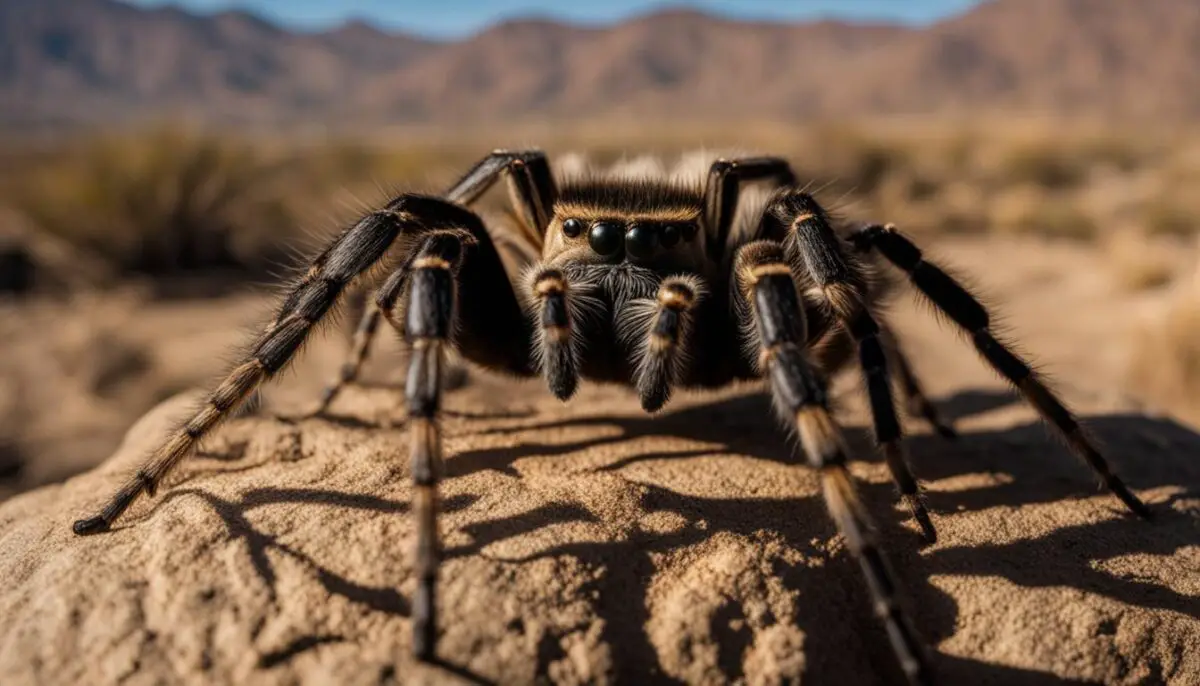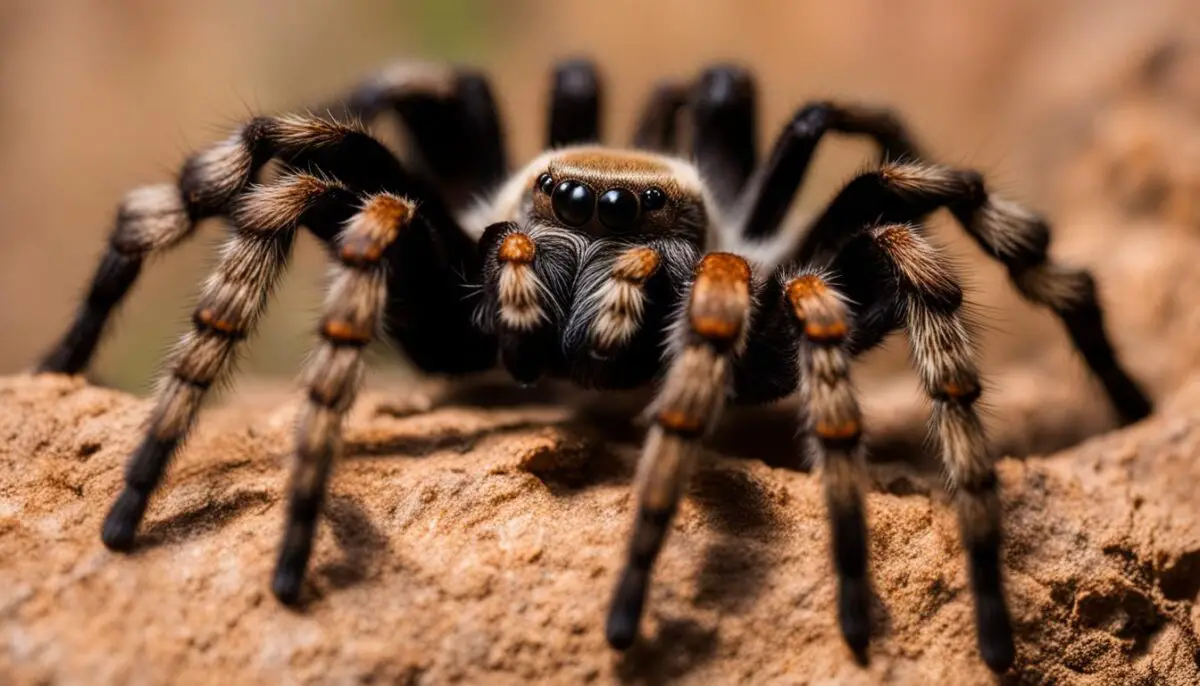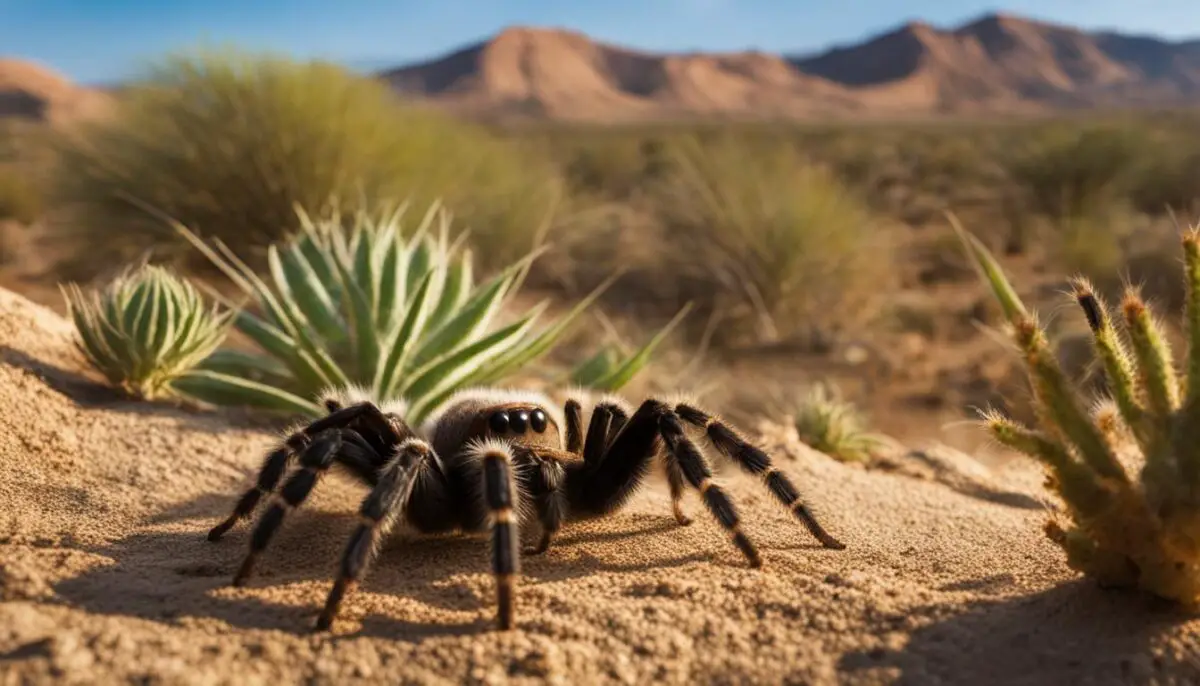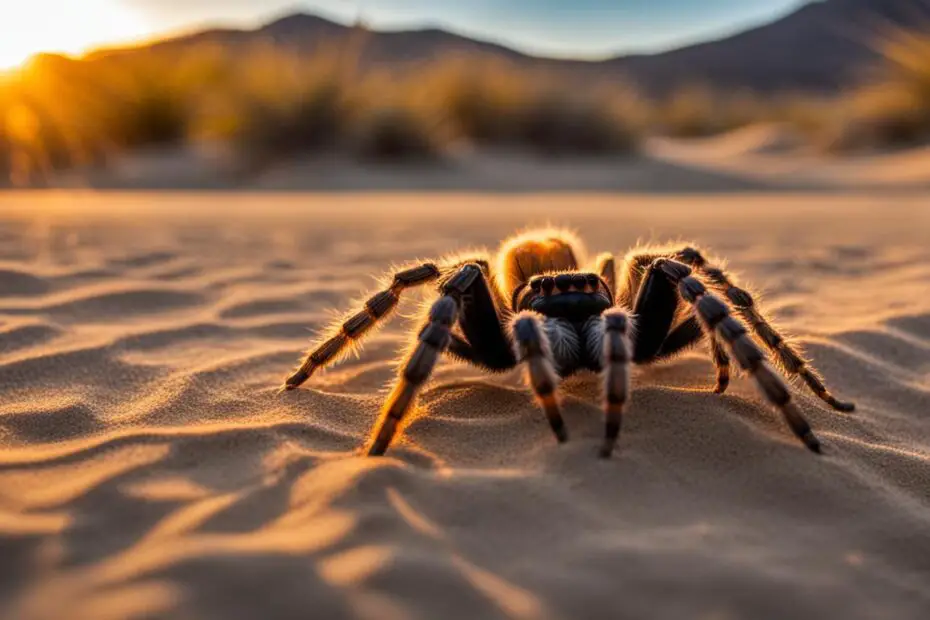Welcome to your complete guide on where tarantulas live in Texas! If you have ever been curious about these fascinating creatures and their habitats, you’ve come to the right place. Texas is home to a diverse range of tarantula species, with 14 known species listed in the genus Aphonopelma. From their preferred locations to their life cycle and role in ecosystems, we will explore everything you need to know about tarantulas in Texas.
Key Takeaways:
- Texas is home to 14 species of tarantulas in the Aphonopelma genus.
- Tarantulas can be found in various habitats across Texas, including grasslands, semi-open areas, and old rodent burrows.
- Their diet consists of crickets, beetles, grasshoppers, and caterpillars.
- Female tarantulas can lay between 100 to 1,000 eggs and guard them in their burrows.
- Tarantulas play a vital role in maintaining the balance of ecosystems by controlling insect populations.
Where do Tarantulas live in Texas
The Life Cycle of Tarantulas
Tarantulas have a fascinating life cycle that begins with the female laying eggs. Female tarantulas can lay anywhere from 100 to 1,000 eggs in a web that they construct like a hammock. This egg sac is retained in the burrow and guarded by the female. After approximately 45 to 60 days, the eggs hatch, and the spiderlings emerge from the sac. These spiderlings may stay with the females for a few days before dispersing to begin their own burrows. where do tarantulas live in Texas
During the dispersal period, many of the young tarantulas may fall prey to other spiders or predators. It’s a challenging time for them as they venture out on their own. Interestingly, males in Texas rarely live more than a few months after reaching maturity. On the other hand, females can live in captivity for over 25 years, making them a long-term commitment for those who choose to keep them as pets. tarantula habitat Texas
To better understand the life cycle of tarantulas, let’s take a look at the table below:
| Stage | Description |
|---|---|
| Egg Stage | Female tarantulas lay eggs in a web sac that they guard in their burrow. |
| Spiderling Stage | Spiderlings hatch from the eggs and may stay with the female for a few days before dispersing to find their own burrows. |
| Adult Stage | After several molts, tarantulas reach maturity and continue their life cycle. |
Understanding the life cycle of tarantulas provides valuable insights into their behavior and development. It showcases the challenging journey that spiderlings face as they journey into adulthood and highlights the long lifespan potential of female tarantulas. tarantula habitat Texas
Tarantulas in Texas Habitats
Tarantulas occur throughout Texas and can be found in different habitats, including grasslands and semi-open areas. They use burrows, natural cavities, spaces under logs and stones, and even old rodent burrows as shelters. Some tarantulas also dig their own burrows. They typically remain in their burrows, waiting for prey to pass by, but they may venture out a few meters to forage when necessary. Tarantulas in Texas also use webbing to line their shelter and detect passing prey. tarantula distribution in texas
Tarantulas are well adapted to the diverse ecosystems of Texas. They have the ability to thrive in various environmental conditions, contributing to the balance of these ecosystems. Their presence helps control insect populations, as they feed on crickets, beetles, grasshoppers, and caterpillars. By regulating these populations, tarantulas play a crucial role in maintaining the natural balance of the ecosystem. texas tarantula species
While grasslands and semi-open areas are the primary habitats for tarantulas in Texas, they can also be found in other locations. These include prairies, deserts, and forests. Tarantulas have the flexibility to adapt to different habitats, as long as there is sufficient food and shelter available. Their ability to utilize a variety of habitats demonstrates their resilience and ability to thrive in diverse environments. tarantula habitats in texas
In summary, tarantulas in Texas can be found in a range of habitats, including grasslands, semi-open areas, and even forests. They rely on burrows and natural cavities for shelter and use webbing to detect passing prey. Tarantulas contribute to the balance of ecosystems by controlling insect populations. Their ability to adapt to different habitats showcases their resilience and importance in the natural environment. texas tarantula locations
Texas Tarantula Species
When it comes to tarantulas, Texas is home to a diverse range of species. Among the 14 known species in Texas, some of the common ones include Aphonopelma hentzi (Texas brown tarantula), Aphonopelma anax (Texas tan tarantula), Aphonopelma armada (Texas black spot), Aphonopelma moderatum (Rio Grande gold tarantula), Aphonopelma hollyi (Lubbock gold tarantula), Aphonopelma gabeli, and Aphonopelma moellendorfi. Each of these species has its own unique characteristics and habitats. texas tarantula habitats
Identifying these tarantula species can be challenging and requires specialized knowledge and equipment. Tarantula enthusiasts and researchers play a vital role in studying and cataloging the diversity of tarantulas in Texas, contributing to our understanding of these fascinating creatures and their ecosystems. texas tarantula ecosystems
Here is a table highlighting some of the key characteristics of the different tarantula species found in Texas:
| Tarantula Species | Common Name | Habitat | Size |
|---|---|---|---|
| Aphonopelma hentzi | Texas brown tarantula | Grasslands, semi-open areas | Leg span up to 4 inches |
| Aphonopelma anax | Texas tan tarantula | Southeastern areas of Texas, Northern Mexico | Female: Leg span up to 6 inches |
| Aphonopelma armada | Texas black spot | Various habitats | Leg span varies |
| Aphonopelma moderatum | Rio Grande gold tarantula | Rio Grande Valley region | Leg span varies |
| Aphonopelma hollyi | Lubbock gold tarantula | South Plains region | Leg span varies |
| Aphonopelma gabeli | – | Various habitats | Leg span varies |
| Aphonopelma moellendorfi | – | Various habitats | Leg span varies |

Tarantula Diversity in Texas
The range of tarantula species found in Texas reflects the state’s rich biodiversity. From the iconic Texas brown tarantula to the elusive Lubbock gold tarantula, these spiders contribute to the ecological balance of their respective habitats. While some tarantula species have specific preferences for certain regions, others are more adaptable and can thrive in a variety of environments.
Studying the diversity of tarantulas in Texas not only provides insights into their evolutionary history and behavior but also helps to conserve and protect their populations. By understanding the different species and their natural habitats, we can work towards ensuring the preservation of these unique and fascinating creatures for future generations to enjoy.
Distribution of Tarantulas in Texas
Tarantulas are distributed throughout Texas, with the highest concentration of activity in south Texas. They can also be found in neighboring states such as New Mexico, Oklahoma, Kansas, Colorado, Arkansas, Arizona, California, and Nevada. Texas offers a diverse range of tarantulas, with as many as 18 species documented in the mid-1800s and currently 14 known species. Their adaptability allows them to thrive in various environments and contribute to the balance of ecosystems.
The distribution of tarantulas in Texas reflects their ability to adapt to different habitats and climates. The southern regions of the state, especially near the Mexican border, provide ideal conditions for tarantulas to thrive. The warm climate and diverse ecosystems create a suitable environment for various species.
Within Texas, tarantulas can be found in a variety of locations, including grasslands, semi-open areas, and natural cavities. They often use burrows and old rodent burrows as shelters, where they wait for prey to pass by. Tarantulas are also known to venture out a few meters from their burrows to forage when necessary.
Texas Tarantula Distribution by County
| County | Number of Tarantula Species |
|---|---|
| Bexar | 9 |
| Hidalgo | 8 |
| Webb | 6 |
| El Paso | 5 |
| Nueces | 4 |
These counties have been identified as having the highest tarantula diversity in Texas. However, tarantulas can be found in many other counties across the state, contributing to the overall richness of Texas’s tarantula populations.
The Texas Brown Tarantula
The Texas brown tarantula, scientifically known as Aphonopelma hentzi, is one of the most common tarantula species found in Texas. These fascinating creatures have a leg span that can reach up to 4 inches and weigh around 3 ounces. Texas brown tarantulas are predominantly ground spiders that prefer to hide under logs, rocks, and in underground burrows.

Despite their large size, Texas brown tarantulas are not aggressive towards humans. In fact, they are generally docile and non-threatening. However, like most tarantulas, they have a natural defense mechanism. When threatened, a Texas brown tarantula may raise its legs and exhibit threatening behavior. It can also release urticating hairs from its abdomen, causing irritation to the eyes or skin of an attacker.
One of the main predators of the Texas brown tarantula is the tarantula hawk, a large wasp species. Tarantula hawks specifically target tarantulas as their main source of food. These wasps are known for their painful sting, which they use to paralyze tarantulas. Once paralyzed, the wasp lays its eggs on the tarantula’s body, providing a living food source for its offspring.
Table: Tarantula Predators
| Predator | Description |
|---|---|
| Tarantula Hawks | Large wasps that prey on tarantulas. They sting and paralyze tarantulas, using their bodies as food for their young. |
| Snake Species | Some snake species, such as the coachwhip snake, feed on tarantulas when given the opportunity. |
| Other Spiders | Large spider species, including other types of tarantulas, may also prey on Texas brown tarantulas. |
The Texas brown tarantula is a fascinating and important part of the ecosystem in Texas. While they may cause concern due to their appearance, these tarantulas play a vital role in maintaining the balance of nature by controlling insect populations. Their presence contributes to the overall biodiversity and functioning of the ecosystems they inhabit.
The Texas Tan Tarantula
The Texas tan tarantula, scientifically known as Aphonopelma anax, is one of the largest tarantula species found in Texas and the United States. They are primarily found in the southeastern areas of Texas and Northern Mexico. Female Texas tan tarantulas can grow considerably larger than males, with a leg span reaching up to 6 inches. They are docile and often kept as pets.
Texas tan tarantulas are known for their striking appearance. They have a dark brown to black body and legs, and their abdomen is covered in fine hairs. These hairs help them sense their environment and protect them from predators.
Despite their intimidating size, Texas tan tarantulas are generally harmless to humans. They rarely bite unless they feel threatened, and their venom is not considered dangerous. However, it is important to handle them with care and respect their space. Their bites can still cause irritation or allergic reactions in some individuals.
“The Texas tan tarantula is a fascinating species known for its impressive size and gentle nature. Its striking appearance and docile temperament make it a popular choice for tarantula enthusiasts and pet owners.” – Tarantula expert
Other Tarantula Species in Texas
Along with the Texas brown and Texas tan tarantulas, there are several other tarantula species found in Texas. These additional species contribute to the rich diversity of tarantulas in the state. Here are a few notable examples:
Aphonopelma armada (Texas black spot)
The Aphonopelma armada, commonly known as the Texas black spot tarantula, is a fascinating species found in various parts of Texas. It gets its name from the distinctive black spots on its abdomen. They can reach a leg span of up to 5 inches, making them one of the larger tarantula species in Texas. These tarantulas primarily inhabit grasslands and are known for their docile nature.
Rio Grande gold tarantula (Aphonopelma moderatum)
The Rio Grande gold tarantula, scientifically known as Aphonopelma moderatum, is another tarantula species found in Texas. As the name suggests, they have a beautiful golden coloration. These tarantulas prefer arid habitats and are often found in the southwestern regions of Texas. With a leg span of around 4 inches, they are moderately sized tarantulas with a striking appearance.
| Tarantula Species | Common Name | Habitat |
|---|---|---|
| Aphonopelma armada | Texas black spot tarantula | Grasslands |
| Aphonopelma moderatum | Rio Grande gold tarantula | Southwestern Texas |
| Aphonopelma hollyi | Lubbock gold tarantula | Lubbock County, Texas |
| Aphonopelma gabeli | — | — |
| Aphonopelma moellendorfi | — | — |
These are just a few examples of the diverse tarantula species that call Texas their home. Each species has its own unique characteristics and contributes to the fascinating world of tarantulas in Texas.

Did you know? Texas is home to a diverse range of tarantula species, with 14 species listed in the genus Aphonopelma. Identifying these species can be challenging and requires specialized knowledge and equipment.
Tarantulas as Pets
Tarantulas, including various species found in Texas, are popular pets among enthusiasts. They can be kept in appropriate enclosures and require specialized care. Tarantulas are generally docile and low-maintenance pets, but they still require proper housing, feeding, and handling precautions.
If you are considering keeping a tarantula as a pet, it is important to research and understand the specific needs of the species. Different tarantula species may have different requirements in terms of temperature, humidity, substrate, and prey items. Creating a suitable habitat that mimics their natural environment is crucial for their well-being.
Feeding tarantulas is relatively simple as they primarily eat insects such as crickets, roaches, and mealworms. Live prey is usually the best option, as it allows the tarantula to exhibit natural hunting behaviors. However, some tarantulas may also accept pre-killed prey or even commercial diets made specifically for tarantulas.
| Pros of Keeping Tarantulas as Pets | Cons of Keeping Tarantulas as Pets |
|---|---|
|
|
It is important to note that while tarantulas are generally not aggressive towards humans, some individuals may be more defensive than others. Handling tarantulas should be done with caution, using proper techniques to minimize stress for both the tarantula and the handler. It is recommended to seek guidance from experienced tarantula keepers or experts to ensure the well-being of your pet.

As top-level predators, tarantulas help regulate the populations of their prey species. By controlling insect numbers, they help maintain the delicate balance of the food chain. This ultimately prevents the overpopulation of pest species, reducing the need for harmful pesticides and promoting a healthier environment.
Additionally, tarantulas serve as a source of food for other animals in the ecosystem. Their presence provides sustenance for larger predators, such as birds, reptiles, and small mammals. By occupying this vital role in the food web, tarantulas contribute to the overall stability and health of the ecosystem.
Furthermore, tarantulas contribute to the decomposition process. When tarantulas capture and consume their prey, they help break down organic matter, releasing essential nutrients back into the soil. This nutrient cycling is crucial for the growth and vitality of plants, contributing to the overall productivity of the ecosystem.
Tarantulas and Their Impact on Ecosystems
The ecological significance of tarantulas cannot be understated. These remarkable creatures play a vital role in maintaining the delicate balance of Texas’ ecosystems. Through their predation, tarantulas control insect populations, provide a food source for other animals, and contribute to nutrient cycling. As we continue to explore and appreciate the natural world, understanding and acknowledging the role of tarantulas in ecosystems is essential for their conservation and the preservation of the intricate web of life.
Tarantulas and Human Interaction
Encounters with tarantulas can be intimidating for some people due to their large size and hairy appearance. However, it is important to note that tarantulas are generally not a threat to humans. Their bites are typically harmless and result in pain sensations similar to a bee sting. Tarantulas only bite when they feel threatened, so it is important to avoid provoking or handling them in a way that may cause them to defend themselves.
In the rare event of a tarantula bite, it is recommended to clean the wound thoroughly with soap and water to prevent infection. Applying an antiseptic cream and a cold compress can help alleviate any discomfort or swelling. It is advisable to seek medical attention if there are signs of an allergic reaction or if the bite does not heal properly.
When encountering a tarantula in the wild, it is best to observe from a safe distance and avoid any actions that may startle or agitate the spider. It is important to remember that tarantulas are beneficial creatures that play a vital role in ecosystems by controlling insect populations. They contribute to the balance of nature and should be respected and appreciated for their role in the environment.
“Encounters with tarantulas can be intimidating for some people due to their large size and hairy appearance.”
Table: Tarantula Bites – First Aid Steps
| Step | Description |
|---|---|
| 1 | Clean the wound with soap and water |
| 2 | Apply an antiseptic cream |
| 3 | Use a cold compress to reduce swelling |
| 4 | Seek medical attention if necessary |
Conclusion
In conclusion, tarantulas are a fascinating and relatively common part of Texas’s wildlife. With 14 known species in the state, these spiders can be found in various habitats, such as grasslands and semi-open areas. While their large size and appearance may cause concern for some, it’s important to note that tarantulas are generally not a threat to humans. Their bites are usually harmless, resulting in pain similar to that of a bee sting.
Tarantulas play an essential role in maintaining the balance of ecosystems. As predators, they help control insect populations by feeding on crickets, beetles, grasshoppers, and caterpillars. Their presence in Texas contributes to natural pest control, benefiting both wildlife and humans. These creatures are an integral part of the state’s biodiversity and contribute to the rich wildlife diversity that Texas is known for.
In summary, tarantulas are fascinating creatures that are worthy of appreciation and respect. Their unique characteristics, diverse habitats, and important role in ecosystems make them a valuable part of Texas’s natural heritage. So, next time you come across a tarantula in Texas, remember that these creatures are just another fascinating aspect of the state’s rich wildlife diversity.
FAQ
Where can tarantulas be found in Texas?
Tarantulas are relatively common throughout Texas and can be found in various habitats such as grasslands, semi-open areas, burrows, natural cavities, and old rodent burrows.
How many species of tarantulas are listed in Texas?
There are 14 species of tarantulas in the genus Aphonopelma listed in Texas.
How big do tarantulas in Texas grow?
Tarantulas in Texas can grow to about 1 ½ inches in body length, making them the heaviest spiders in the region.
What do tarantulas in Texas eat?
Tarantulas in Texas typically feed on crickets, beetles, grasshoppers, and caterpillars.
How many eggs do female tarantulas lay?
Female tarantulas in Texas can lay between 100 to 1,000 eggs in a web that they construct like a hammock.
How long does it take for tarantula eggs to hatch?
Tarantula eggs in Texas hatch in 45 to 60 days, and the spiderlings emerge from the sac.
How long can female tarantulas live in captivity?
Female tarantulas in Texas can live in captivity for over 25 years, while males rarely live more than a few months after reaching maturity.
What are the habitats of tarantulas in Texas?
Tarantulas in Texas use various habitats such as grasslands, semi-open areas, burrows, natural cavities, and old rodent burrows.
How many tarantula species are there in Texas?
There are 14 known species of tarantulas in Texas, including Aphonopelma hentzi, Aphonopelma anax, Aphonopelma armada, Aphonopelma moderatum, Aphonopelma hollyi, Aphonopelma gabeli, and Aphonopelma moellendorfi.
Where else can tarantulas be found besides Texas?
Tarantulas can also be found in neighboring states such as New Mexico, Oklahoma, Kansas, Colorado, Arkansas, Arizona, California, and Nevada.
Can tarantulas be kept as pets?
Yes, tarantulas, including various species found in Texas, can be kept as pets. However, they require specialized care and proper housing.
What is the role of tarantulas in ecosystems?
Tarantulas play a vital role in maintaining the balance of ecosystems as predators. They help control insect populations by feeding on crickets, beetles, grasshoppers, and caterpillars.
Are tarantula bites dangerous to humans?
Tarantula bites in Texas are generally not serious to humans. Tarantulas typically only bite when threatened, and their bites result in pain sensations similar to a bee sting.


It’s remarkable in support of me to have a site, which is helpful
for my knowledge. thanks admin
What’s up, its nice article on the topic of media print, we all be aware
of media is a fantastic source of information.
Greetings! I know this is somewhat off topic but I was wondering which blog platform are you using for this website?
I’m getting fed up of WordPress because I’ve had
issues with hackers and I’m looking at alternatives for another platform.
I would be fantastic if you could point me in the direction of a good platform.
This is very fascinating, You are an overly skilled blogger.
I’ve joined your rss feed and look forward to in search of extra of your great post.
Additionally, I’ve shared your web site in my social networks